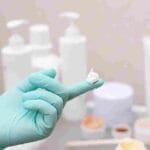
How to Care for Your Skin After a Chemical Peel for Best Results
February 16, 2025
Erase Wrinkles & Fine Lines: The Power of Exosome Facials in Coral Gables
February 16, 2025Acne scars can be frustrating, affecting both confidence and skin appearance. If you’ve tried countless creams and treatments without success, you may be wondering: Do chemical peels work for acne scars?
The answer is yes—when done professionally and using the right type of peel for your skin. Chemical peels help remove damaged skin layers, promote collagen production, and improve skin texture. However, not all peels are created equal.
This guide will explore the best chemical peels for acne scars, how they work, and which one might be the right fit for you. Plus, we’ll explain why DIY peels aren’t the answer and why professional treatment at Pōk Aesthetic Bar in Coral Gables is your best option.
Key Takeaways
- Chemical peels effectively reduce acne scars by exfoliating the top layers of skin.
- There are three types: superficial, medium, and deep peels—each addressing different scar depths.
- Popular chemical agents include glycolic acid, salicylic acid, lactic acid, and trichloroacetic acid (TCA).
- Professional application is essential to avoid complications and maximize results.
- Pōk Aesthetic Bar in Coral Gables offers personalized chemical peel treatments t
Overview
Chemical peels are skin treatments that involve applying a chemical solution to exfoliate the outer layer of the skin. Over the next few days, the old, damaged skin peels away, revealing smoother, healthier skin underneath.
For acne scars, certain peels can help fade discoloration, smooth out uneven texture, and stimulate collagen production, leading to clearer, more even-toned skin.
However, the right type of peel depends on the severity of your scars and your skin type. Below, we break down the best chemical peels for treating acne scars and what you need to know before undergoing treatment.
Best Chemical Peels for Acne Scars
1. Glycolic Acid Peel (Superficial Peel)
Best for: Mild acne scars, hyperpigmentation, and uneven texture
Downtime: Minimal (1-3 days of mild peeling)
How it works: Glycolic acid (AHA) gently exfoliates the surface layers, improving skin tone and radiance.
Who should get this? Ideal for those with mild scarring and sensitive skin looking for a gentle but effective treatment.
2. Salicylic Acid Peel (Superficial Peel)
Best for: Oily, acne-prone skin with lingering scars
Downtime: Minimal (1-3 days of mild peeling)
How it works: Salicylic acid (BHA) penetrates deep into oil glands, unclogging pores and reducing post-acne marks.
Who should get this? If you still experience breakouts alongside mild acne scars, this peel is ideal.
3. TCA Peel (Medium-Depth Peel)
Best for: Moderate acne scars, uneven texture, and deeper pigmentation issues
Downtime: 7-10 days (visible peeling and redness)
How it works: Trichloroacetic acid (TCA) penetrates deeper into the skin, stimulating collagen and resurfacing scarred areas.
Who should get this? Best for those with more noticeable scarring who can handle some downtime for stronger results.
4. Jessner’s Peel (Medium-Depth Peel)
Best for: Stubborn acne scars, hyperpigmentation, and rough skin texture
Downtime: 5-7 days (visible peeling and flaking)
How it works: Combines salicylic acid, lactic acid, and resorcinol for a multi-layered exfoliation process.
Who should get this? If you have textured acne scars and discoloration, this peel provides deep exfoliation and brightening effects.
5. Phenol Peel (Deep Peel)
Best for: Severe acne scars and deep skin damage
Downtime: 2-3 weeks (intensive peeling and recovery time required)
How it works: Phenol deeply resurfaces the skin, completely removing damaged layers.
Who should get this? This is the most intensive peel and is only recommended for those with severe scarring and lighter skin tones due to a higher risk of pigmentation changes.
Why Choose a Professional Chemical Peel?
Many people attempt DIY chemical peels at home, but this can lead to serious skin damage, burns, and uneven results. Professional treatments at Pōk Aesthetic Bar provide:
- Customized chemical peels for your skin type and concerns.
- Safe application with expert precision.
- Stronger results with medical-grade ingredients.
- Minimal risk of complications compared to at-home peels.
Conclusion
The best chemical peels for acne scars depend on your skin type, severity of scarring, and desired results. Whether you need a gentle exfoliation or a deeper resurfacing treatment, professional guidance is key to achieving the best outcome.
Say goodbye to acne scars! Book your expert chemical peel at Pōk Aesthetic Bar in Coral Gables today. Call (786) 578-5303 and let our specialists help you achieve smoother, more radiant skin.
FAQs
Q: How many chemical peels are needed for acne scars?
A: Results vary, but most people see improvement after 3-6 treatments, spaced a few weeks apart.
Q: Are chemical peels painful?
A: Some tingling or mild stinging is normal, but most treatments are well-tolerated with professional application.
Q: What’s the recovery time for a chemical peel?
A: Superficial peels require minimal downtime, while medium to deep peels may take several days to weeks for full healing.
Q: Can I wear makeup after a chemical peel?
A: It’s best to wait at least 48 hours before applying makeup to allow proper skin healing.
Q: How long do chemical peel results last?
A: The longevity of results depends on the type of peel and how well you care for your skin afterward. Superficial peels may require maintenance treatments every few weeks, while medium and deep peels can last several months to years with proper skincare.
Q: Are chemical peels safe for darker skin tones?
A: Yes, but some peels have a higher risk of hyperpigmentation in darker skin. Superficial peels with glycolic acid or salicylic acid are generally safe, but deeper peels should only be done under the supervision of a professional to avoid pigmentation issues.
Q: Can a chemical peel completely remove acne scars?
A: While chemical peels can significantly improve the appearance of acne scars by resurfacing the skin and boosting collagen, they may not completely erase deep scars. A combination of treatments, such as microneedling or laser therapy, might be needed for severe scarring.
Q: What should I do before getting a chemical peel?
A: Before your appointment, avoid sun exposure, exfoliating products, and retinoids for at least a week. A professional consultation at Pōk Aesthetic Bar will help determine your skin’s suitability for the treatment.
Q: What should I expect during the peeling process?
A: After a peel, your skin may appear red, tight, and slightly swollen before it starts flaking or peeling. This can last from a few days to two weeks, depending on the peel depth. It’s essential to follow post-treatment care instructions to ensure proper healing.
Q: Can I go outside after a chemical peel?
A: You can, but it’s crucial to wear SPF 30+ sunscreen as your skin will be more sensitive to UV rays. Excessive sun exposure can lead to pigmentation issues and reduce the effectiveness of the treatment.
Q: How soon can I wear makeup after a chemical peel?
It’s best to wait at least 48 hours before applying makeup to allow your skin to recover properly. For deeper peels, your provider will give you a timeline based on your A:healing progress.

